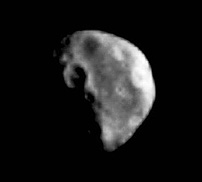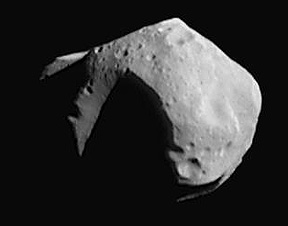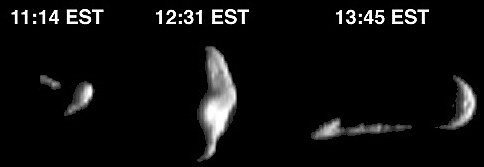

Asteroids and Comets
Interest has always been high regarding the asteroids, tens of thousands of which occupy the Main Belt, an interval of mean distance 2.4 A.U., between Mars and Jupiter. Telescopic observations have indicated that about 75% of the asteroids have very low albedos, which is consistent with compositions that are similar to carbonaceous chondrite meteorites, postulated as the most primitive solar system material. Metallic iron may enrich some asteroids, which could be sources of the iron-nickel meteorites. Other (about 17%) asteroid groups occur in different locations, such as the Apollo belt (Earth-crossing) and Trojan belt (Jupiter-crossing).
About 7000 asteroids have been discovered so far (some astronomers have estimated a total of at least 400,000 exist within the solar system). More being found each year owing to a stepped-up search program (partly in response to recent Asteroid movies that trade on the incredible catastrophe that could result if a large asteroid strikes the Earth). The biggest known asteroid is Ceres (933 km [583 miles]); second is Pallas (530 km [331 miles]) and Vesta is slightly smaller. The Earth-crossing asteroids all are less than 10 km in maximum dimension. Nearly all asteroids have irregular shapes.
The asteroids are the principal source of nearly all meteorites. The origin of the Main Belt asteroids is still open to debate. Many astronomers consider them to be fragments of a ruptured planet. Others consider them to be planetesimal fragments in process of organizing into a planet but their varitations in composition imply some degree of differentiation - unlikely in individuals that are small.
Designers programmed the Galileo spacecraft to transit close to two asteroids. It passed the first, Gaspra, in 1991. This asteroid, 19 x 12 x 11 km (~12 x 7.5 x 7 mi) in size, consists of iron-nickel and iron-magnesium-rich silicates. This is how it appears in color:
Galileo approached and imaged the second asteroid, Ida, on August 28, 1993, as shown here (at about 33 m [108 ft]) resolution:
This asteroid, about 58 km x 23 km (36 km x 14 mi) in dimensions, is chondritic and, like Ida, pockmarked with craters. Totally unexpected was the presence of a small orbiting body, about 1.5 km by 1.2 km (0.93 mi x 0.75 mi), named Dactyl–making this pair the first known binary asteroids. Close-up, Dactyl has a small crater, making it look a bit like Saturn's Mimas in miniature:

The first visit exclusively to the asteroid belt has been made by NEAR, for Near Earth Asteroid Rendezvous mission, launched in June 1997 to reach the large asteroid Eros in January, 1999. Enroute NEAR took a close look at Mathilde (59 x 47 km) as seen here:

NEAR has successfully orbited Eros and has begun to take data on its composition. Below is a view of Eros, whose dimensions of 33 x 13 x 13 km give it a peanut-like shape. Eros is rapidly rotating, as evident from the different positions over a short time span on a December 1998 date.

19-73:
Asteroids, and fragments therefrom, occasionally hit the Earth, as we showed in Section 18, dealing with impact craters. So do comets: a possible example was the 1908 Tunguska event in Siberia, where trees were knocked down over hundreds of square kilometers by an explosion just above the surface. It also threw great amounts of dust into the atmosphere, producing abnormal red sunsets worldwide for the next several years. Comets are among the most spectacular of the heavenly bodies with their long, icy tail, receiving mystical significance from early observers, until later observers determined their true nature.
19-74:
We now know that comets are mainly ice balls of varying sizes (up to 10-30 km [6-19 mi]), mixed with rock debris to some extent. They travel in eccentric orbits (e.g., Kuiper belt) within the solar system, repeating appearances or simply flying through once, if not captured gravitationally. As a comet passes the Sun, the solar wind and other factors cause it to ablate, creating a coma, which is a glowing ball, from 10,000 to 100,000 km (6,214-62,137 mi) in apparent diameter, around the solid nucleus and trailing off as a long tail (up to 100 million km [62,137,000 mi] long) of dust and plasma. The tail points away from the Sun along a radial line. The coma and tail are visible because of reflected sunlight and particles that fluoresce when irradiated by UV light. Scientists think that the nucleus (a dirty snowball) consists of very primitive materials, organized during the solar system's development. Spectroscopic studies indicate the presence of molecular compounds of carbon, nitrogen, and hydrogen, including CN, NH, NH2, and HCN, which break into ions carried into the tail. The number of comets–most still undetected–within the Solar System may be in the millions.
Astronomers know the orbits of some comets well enough (through observations) to predict when they will return. Most comets come from either the Kuiper Belt beyond Pluto or the vast Oort "Clouds" that extend to the outer reaches of the solar system. Some may be intergalatic. As of 1995, 878 comets have been catalogued. Of these 184 are periodic (Short-Period and Long Period types).
Most comets positioned well away from the Sun are without pronounced tails, and are best found by looking for notable displacements of small bright objects (early stage comas) relative to fixed star backgrounds in film records taken days apart. Such motions delineate the advance of comets, as well as reflecting asteroids, at high speeds through solar space.
The best known of all comets is Halley’s Comet, observed and recorded in ancient times. Its periodicity, first predicted by Edmund Halley to verify Newton's Laws of Motion, causes it to reappear about every 76 (range 75 to 79) years. Having passed in 1909, as shown in this wide angle view that displays its magnificent tail, it reappeared in 1986, and many predicted it would provide a great celestial display (which generally fizzled).
Debate raged in advance about sending one or more space probes to examine it close-up, since the next opportunity would not be until 2061. Although NASA decided against this adventure, Japan, the former Soviet Union, and the European Space Agency sent probes to gather data. In particular, the Italian government designed and launched a spacecraft named Giotto, which came within 540 km (336 mi) of the nucleus on March 13, 1986. Here is a close approach view:
Giotta found that Halley's nucleus, measured at 16 km x 8 km (10 x 5 mi), is very dark, lumpy and of low density (0.1-0.2 g/cc). This suggests that it was then very porous, with most of the ice having ablated or evaporated away, leaving carbon-rich dust as a residue. Although not as bright as anticipated and a disappointment to ground viewers, the comet, as seen through telescopes, provided exceptional displays. We can emphasize variations in its coma and tail reflectivity, representing particle density differences, by displaying them in false color:
The latest comet sensation is Comet Hale-Boggs, discovered on July 23, 1995, that passed Earth as close as 85 million miles on April 2, 1997. Hailed by many as the Comet of the Century because of its size (four times larger than Halley’s Comet) and brightness, it was visible in northern and southern hemispheres during much of the first half of 1997. Here is a typical view, taken on March 11, 1997, by Jerry Platt, one of many amateur astronomers who tracked this spectacular celestial visitor.
So far, almost 900 comets have been discovered through telescope searches. Most of those that are far from the Sun don’t have pronounced tails, so to find them we look for notable displacements of small bright objects (early stage comas) relative to fixed star backgrounds in film records, taken days apart. Such motions delineate the advance of comets, as well as reflecting asteroids, at high speeds through the solar system.
The European Space Agency (ESA) is planning another mission (Rosetta) to a comet, Wirlanen, with launch in the year 2003 and arrival in 2009.
19-75:

Primary Author: Nicholas M.
Short, Sr. email: nmshort@epix.net
Contributor Information
Last Updated: September '99
Site Curator: Nannette Fekete